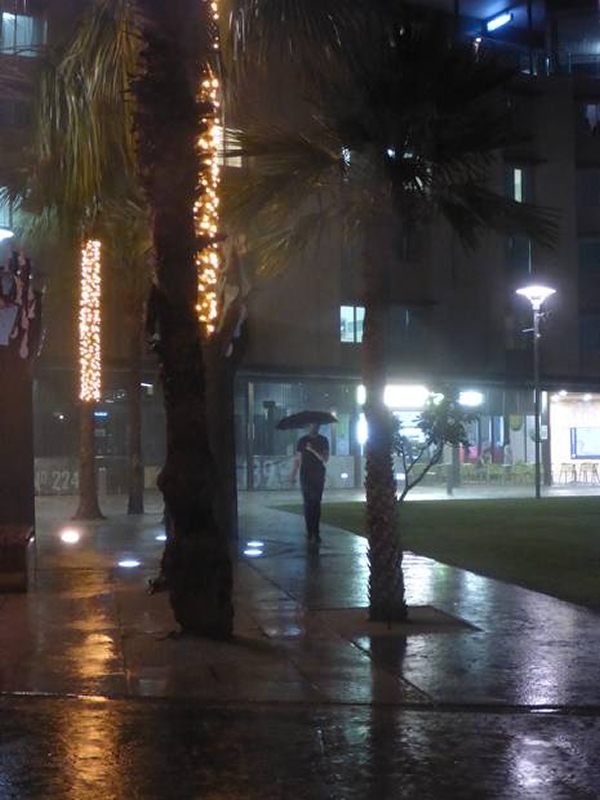Naked Gun Fights to the Bitter End
Our last few hours on The Ghan were spent watching the dramatic change in scenery as we entered the tropical climate of the Top End. The little earth scoops at the side of the track were now underwater and shrouded with greenery. The woodland was becoming lush, still with the hunched ochre termite mounds and small groups of healthy cattle were a reminder of the ambitious cattle ranching days that brought wealth to places like Katherine before successive droughts lasting up to ten years dealt the ranchers’ ambitions a blow from which many never recovered. Ruined ranch houses and broken down fences reminded us of the extreme story of boom and bust in the cattle years.
We were losing the lovely blue sky too. We didn’t know at the time that the monsoon was just a couple of days away. Jamey’s Nitmiluk River level would soon rise at least another metre. Nor did we know what a gem of a place we were slowly sliding towards.
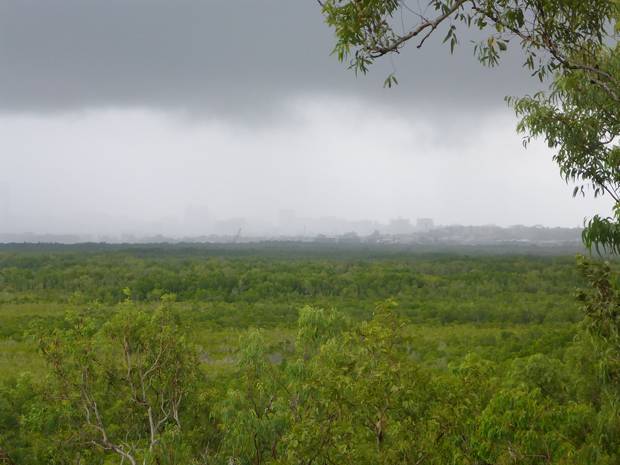
Darwin is named after Charles Darwin of course and is nearer to Jakarta, Capital of Indonesia, than it is to the National Capital of Canberra. It was the commander of the Beagle, John Clements Wickham who in 1839 named the arrival port of his ship Port Darwin, having had Charles Darwin, the public father of the Theory of Evolution aboard on two previous voyages. In 1869 the growing settlement above the escarpment there was named Palmerston after the then British Prime Minister and was finally renamed Darwin like its port in 1911.
You might think it strange that the port once had a different name to the township but they are in quite different locations, the port being at sea level and the town on an elevated cliff behind it. This topographical contrast is one feature that makes Darwin such a pleasant place to live and visit now. The lower port area where we stayed was skirted by one road which left the rest of the area a pleasant mixture of green park, apartments, hotels, a wave pool, bars and restaurants and a lagoon.
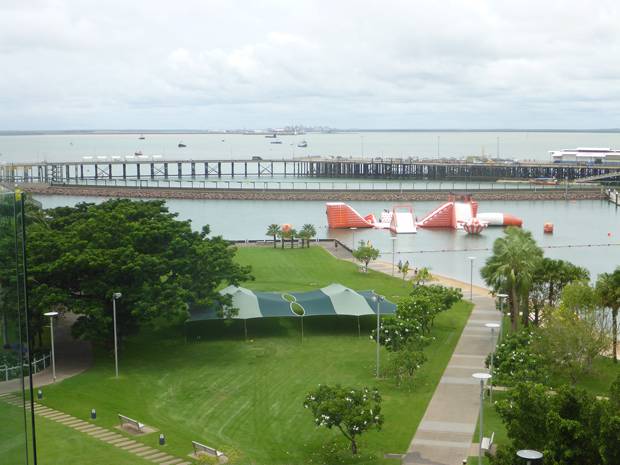


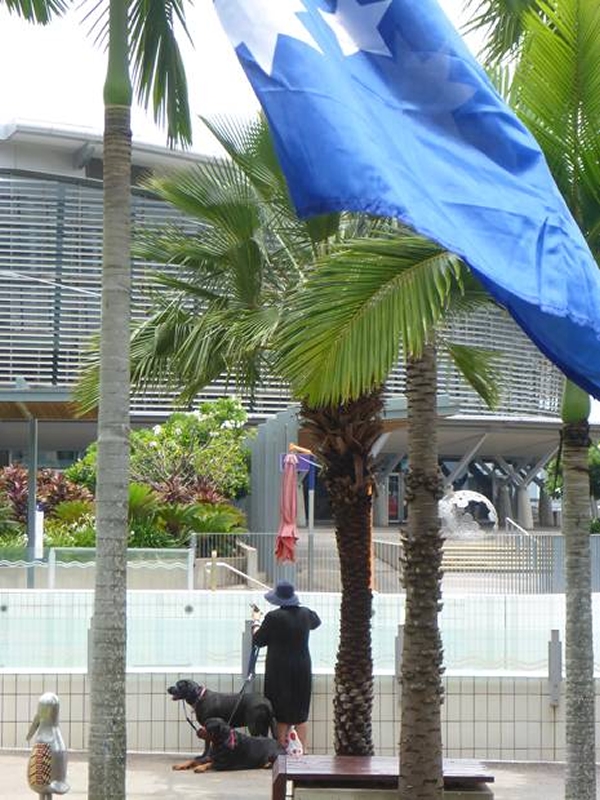
I had read the reviews about the Vibe Adina Hotel, where we were staying in the area still called Port Darwin, so I didn’t hold out any high expectations about the place, not that I ever do anyway so I cannot be disappointed. Complaints about dirty rooms, bumpy pillows, and the distance from the town meant I was quite curious on arrival.
The location away from the bustle of the town meant the whole area was peaceful and safe for children to run around. There were privately owned apartments all around and members of the public along with their lovely dogs as well as visitors could enjoy the bars and restaurants in this non-exclusive area. Our room was spotless, with smooth pillows (!) a fine view over the area and the estuary toward the Timor Sea and best of all, a BATH. I was in to that welcoming receptacle approximately 15 minutes after shutting the room door and I lost count of the number of baths I had in our five day stay.
Access to the town level was up a few floors via the lift and then a walkway, the Sky Bridge which ran along the top of our hotel room block, a relaxing and easy means of getting into town away from noise and traffic.
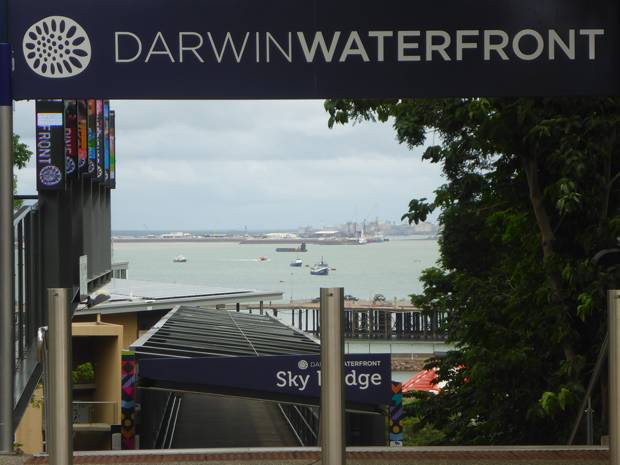
The temperature was a modest and pleasant 31’ but the humidity at the time was 92% and rising. We didn’t need the air con and sometimes opened the window a little at night for the onshore breeze. Once folk had gone home we were left with the sound of cicadas and birdsong.
On the first evening we relaxed on the bed drinking ‘sav’ (Sauvignon Blanc), nibbling nuts from the fridge and watching an episode of Ab Fab on TV. The next morning I baulked at the two bowls of breakfast muesli and yoghurt we had bought for £17.50 in a café downstairs! So from then on we had the same but we bought the yoghurt and cereal from Coles supermarket and ate it in the room! We’re not suckers!
Our Ghan Trip included a half day tour of the town with Warren, a quietly spoken kind natured man, the sort that makes me feel pleased for his partner. He talked interestingly and almost continually while driving us all around Darwin perfectly safely.
Within a few minutes of being aboard not only had we seen a few wallabies but the rain started to come down, it was the first day of the Monsoon. Warren released us into the Darwin Aviation Museum for an agreed period of time and the noise of the rain on the roof rendered conversation impossible and was far louder than the recorded sound of the 1974 Christmas Eve Cyclone when it hit the city with devastating force. Darwin has been flattened 5 times in recent history, three times by cyclones and again during Japanese air raids in 1942 and 1943. After the B52 Bomber the Supermarine Spitfire Mark VIII was so recognisable.
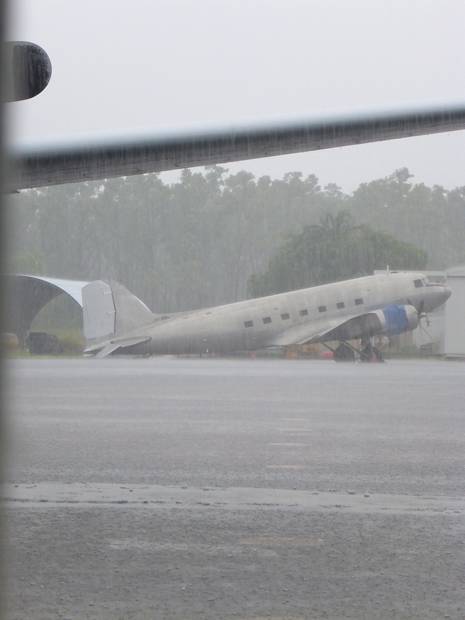
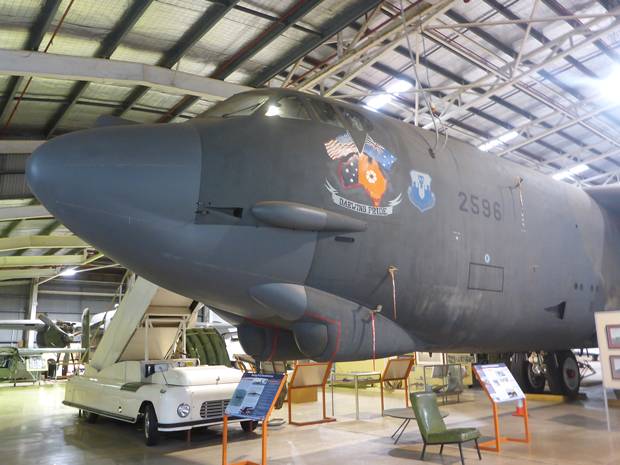
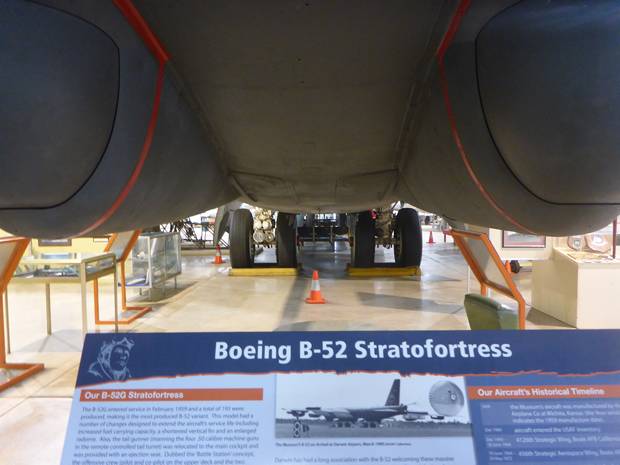
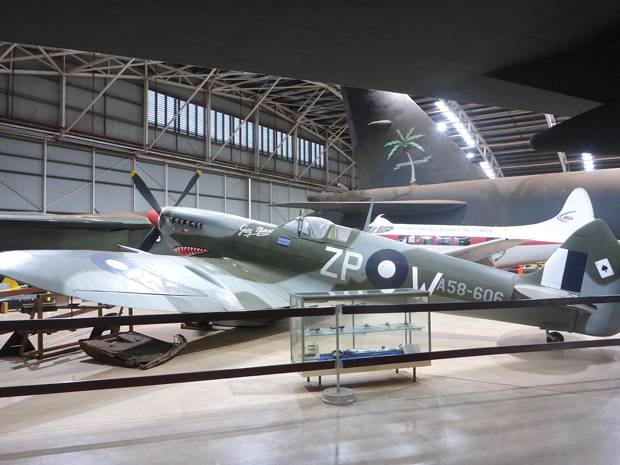
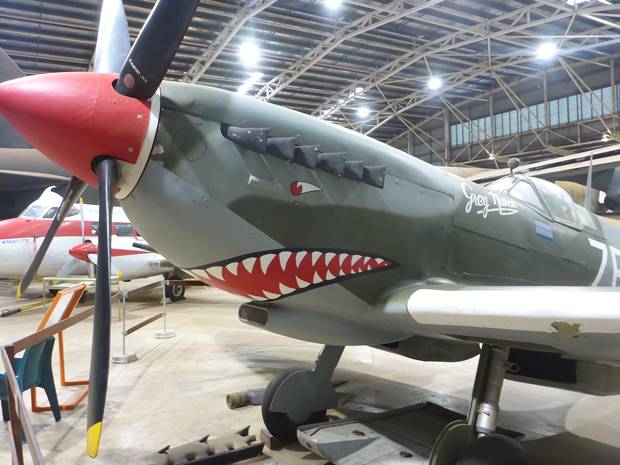
At the time a young soldier, Wilbert ‘Darkie’ Hudson was in the shower when he heard the planes coming and knew they weren’t friendly. Without so much as a thought for grabbing a towel he went outside and manned a gun in defence of the city and gave those airmen hell for the duration of the raid while stark naked.
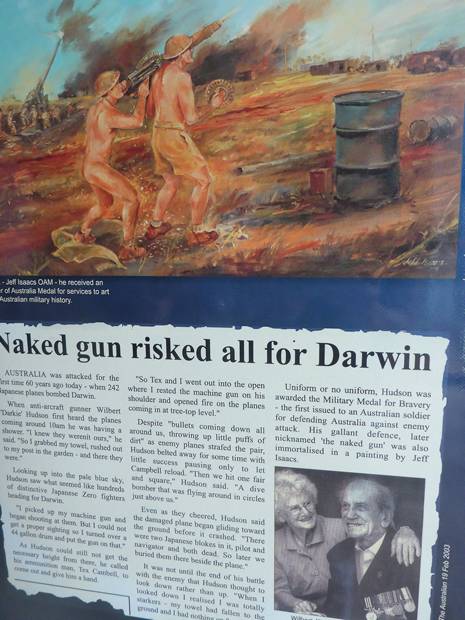

Darwin is still a garrison town with barracks and military bases and as we drove on Warren showed us an old hangar from WW2 which is still in use, oil storage tunnels where fuel oil essential to the defence of the city was stored and we drove down a road that was once a runway to our next destination, The Museum and Art Gallery of the Northern Territory.
A Deadly Submarine a Ship of the Desert and A Remarkable Artistic Collaboration
Way back sometime in the 1920s a baby estuarine salt water crocodile hatched from his egg in the Sweets Lookout Billabong on the Finnis River 55km south west of Darwin, when the heavily laden ships of the desert were still carrying their burdens with long, elegant strides up and down the length of the mother country.
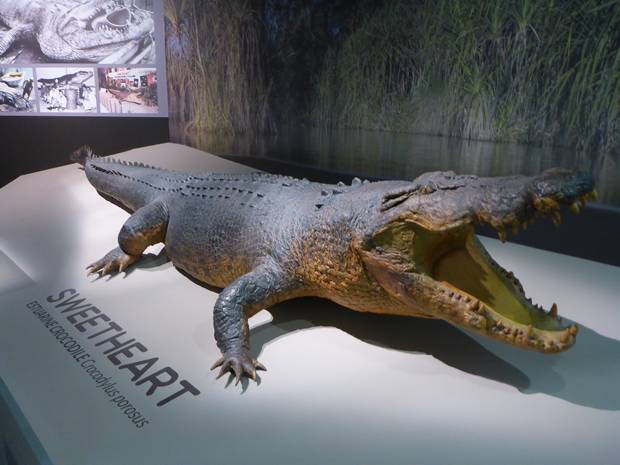

From the 1970’s the billabong became a popular fishing area with little boats powered by outboard motors using its waters to catch the many species of tasty fish that lived there. Our ‘little’ croc was now nearly a half century old and an impressive 5.1 metres long, longer than many of the boats in his billabong. He was also the boss in the area and took the threats to his sovereignty from other male crocs very seriously.
You can imagine that from underneath these little boats with their rods over the sides may look very much like other crocs with spindly legs and it is thought that the vibrations from the outboard motors make a sound similar to that of an angry male crocodile.
Sweetheart, as he was soon to become known after the billabong he lived in, was having none of this. Maybe at his age his sight and hearing were not as good as they had been so he could not distinguish between men in boats and others of his own kind. Maybe the aborigines in their bark canoes with their paddles posed no threat to him because they had always been there and he had grown up with them knowing they were not crocs. Perhaps with the arrival of outboard motors this all changed and he mistook the sound of these motor powered boats to be his rivals.
I think the latter is most likely because from 1974 he started attacking just the motors, ‘the heads’, (motor heads!) as he might have imagined were the other crocs. Some boats were overturned and the occupants pitched into the water but over the next few years, in all of his terrifying attacks not a single fisherman or fisherwoman was harmed.
Of course this could not go on so in 1979 he was anaesthetised ready to be secured with rope and pulled from his home to be re-located. During the process he became entangled in an underwater log and drowned. The human response was one of sorrow, he hadn’t hurt them and they didn’t want to hurt him. Just so he wouldn’t be lost for ever it was decided to taxiderm him and put him on display in the Museum and Gallery of the Northern Territory, which is where we met.
The museum also contains a fine collection of south west Pacific sailing craft and a permanent aboriginal art display, one topic of which I thought might be of interest to you.
During our Australian travels we have often heard of the aborigines, the Yolnu people of Arnhem Land in Northern Territory to the east of Darwin. They were amongst the first to be given back their title to the lands and access to their area of country is now on their terms only. A visitor requires a pass and permission before they can do more than look up the Arnhem and Kakadu Highways that lead to their home, as we did when we passed by a couple of days later on our way to Kakadu National Park.
John Wolseley and the Yolnu elder Mulgun Wirrpanda have combined their anthropological and artistic skills and interests to create a window on Mulgun’s world. The photos speak for themselves along with their captions. What intrigued me was that they meet every year to extend this wealth of artistic information about the natural world around Mulgun and so preserve history as a source of survival for the future. Who knows, maybe with the mass decline of plant and animal species the world is experiencing we may go back to using the plants around us for food instead of treating them as weeds or ignoring them altogether.
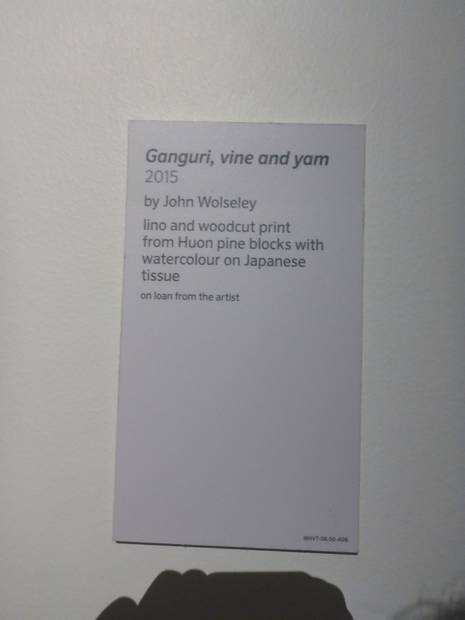
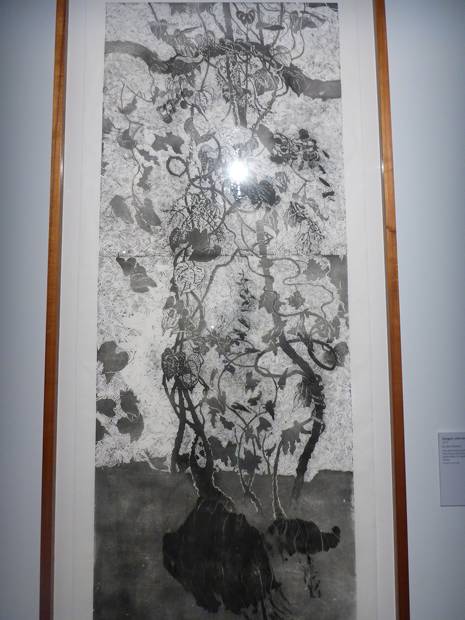
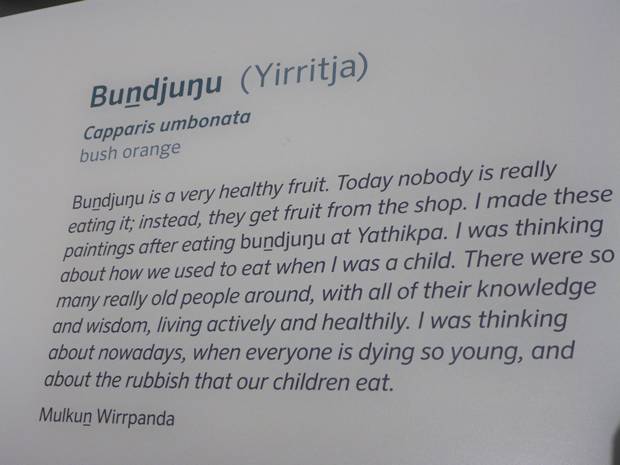
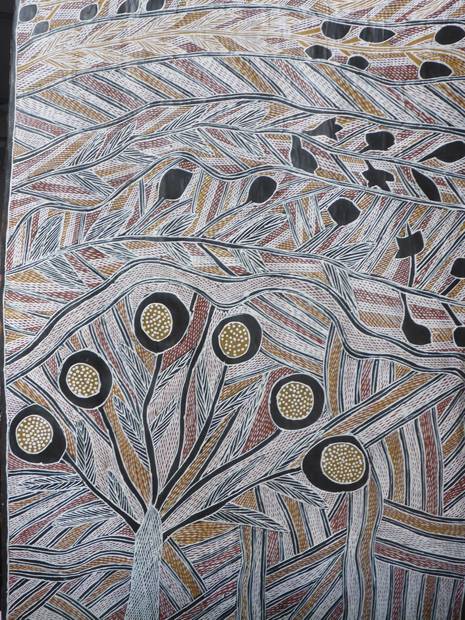
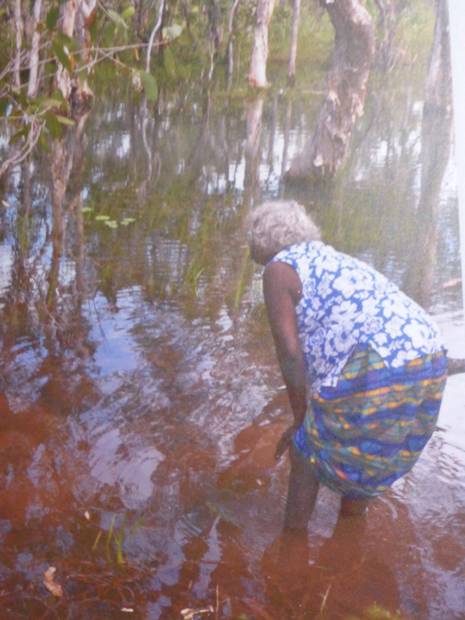
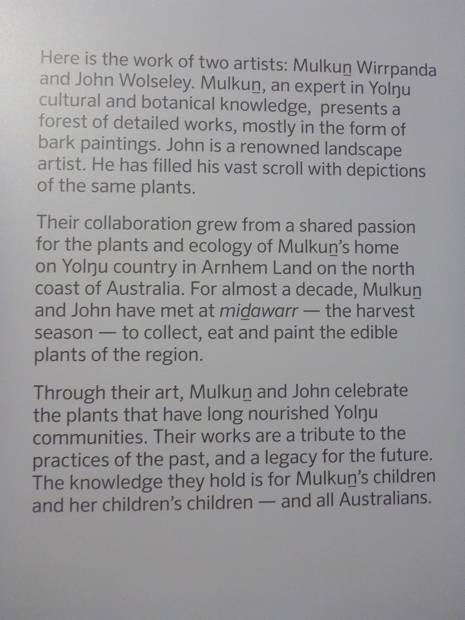
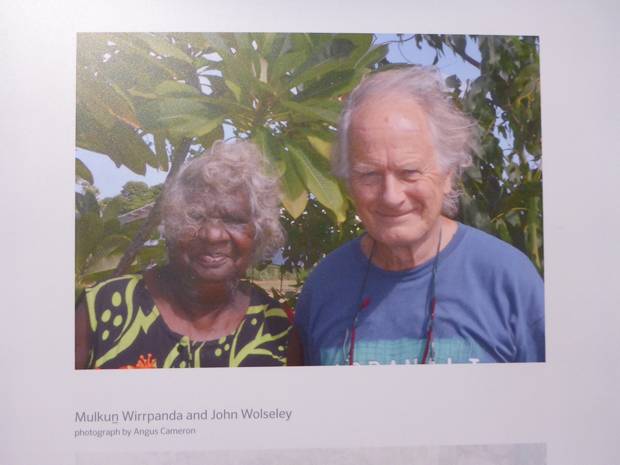
The Everchanging Streets of Darwin
The views you see of the grounds around Port Darwin taken from our hotel window would have looked different if taken before March 2018 when Cyclone Marcus hit and robbed the city of many of its trees. The buildings are unchanged, being built of steel and given the building style referred to as ‘Troppo’ (meaning either excessive or of tropical origin or a mix of both) but there were more trees before Marcus.
Marcus was considered the worst storm since Tracey in 1974, itself the worst in Australian history which destroyed over 70% of the buildings. Both brought winds of 160mph (the anemometer was broken by Tracey when it reached 135mph so the higher figure is an accurate estimate) and Marcus had gusts of 200mph, but few buildings were destroyed this time, testament to the improved building techniques and materials.
Back in 1897 in the city’s infancy the entire collection of lightly constructed buildings were flattened by a cyclone and that, combined with the loss of two ships taking with them many townsfolk meant the area was slow to recover.
So despite 3 major cyclones and 2 Japanese air raids in 1942 and 1943 like a bouncing ball, a very determined phoenix Darwin has risen into a new city each time. The ruins of the Old Town Hall help tell the story but Warren told us the different story of another building you see in the photo of the Roadmasters House which I took from the Darwin Heritage Trail Brochure produced by Northern Territory.com, Live Darwin and the NT Government. This innovative ‘cool indoors’ house was lived in until Tracey arrived and damaged it, necessitating repairs and restoration.
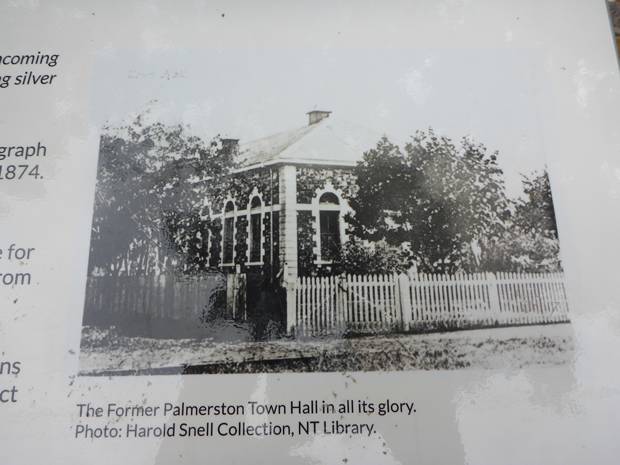
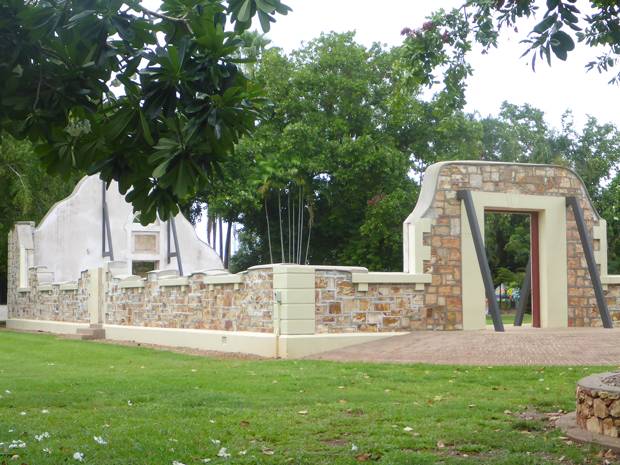
We sat in the coach as another downpour of monsoon, (Gudjewg in the local tongue) dimensions prevented us from exploring or even taking a few photos of the discrete house tucked within its garden of mature greenery. Warren explained the construction of the walls and window louvres that left gaps between all the vertical wooden planks so any breeze would penetrate into the shaded interior and combine with the shade to keep it cool. Totally natural air con and no need for electricity.
It is one of only three such pre-war houses left, built to accommodate staff of the North Australia Railway and is now a museum housing a collection of the instruments used by Gilbert McMinn who was a senior surveyor involved in the construction of the Overland Telegraph Line in 1869.
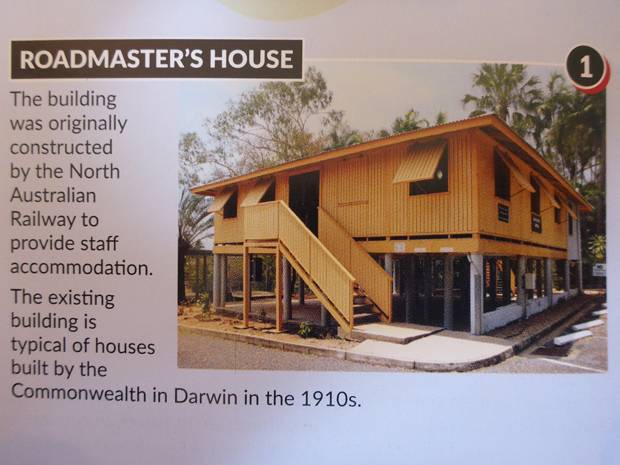
Stone buildings fared better than others through the winds and bombs of history. Built as early as the 1880s using stone from the nearby porcellanite quarries, wood from Asia and slate roof tiles from the UK and still standing clean and proud in the tropical sun we saw The Old Lyons Cottage, substantial houses, The Victoria Hotel, commercial buildings, Administrative buildings including the 1884 Court House and the European style Government house completed in 1879.
The town embraced the Art Deco style for a while and the Hotel Darwin you see in the photo I took as we drove by with Warren was open and serving full English Breakfasts on Christmas Day after Cyclone Tracey delivered much more than presents in her Christmas Eve sack.
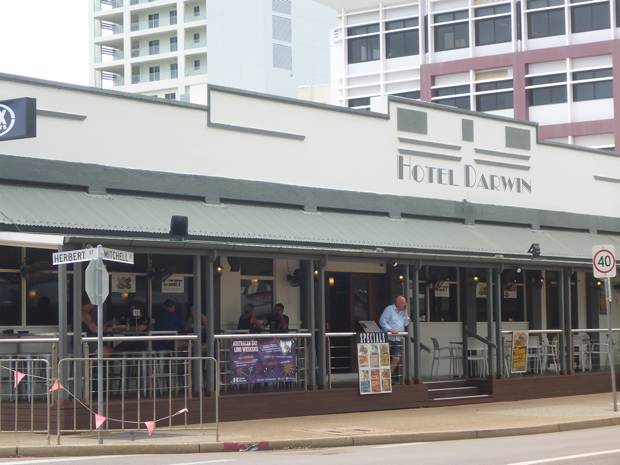
There was nothing nicer after Broke Back and Crook Foot had walked the streets of Darwin, exploring, than to return to the entrance of the Sky Bridge Walkway which sits on the roof of our hotel room wing and descend in the lift emerging to see the lights on in a delightful array of bars and eateries to choose from.
One evening we were in the Fiddlers Green looking back across the paved area towards our room on the second floor (see feature photo) through a solid wall of raindrops wondering if the now regular evening downpour (Magumbu in the local Larrakia tongue) would ease before we wanted to retire or if this was going to be a long session. It didn’t matter. These few days in laid back Darwin felt like a second honeymoon when we could do as we pleased when we pleased after a month of travel and schedules and we were ready for the break.
The next morning was heralded in under a pretty mother of pearl sky and we had to be up and ready by 6.30am for our visit to Kakadu National Park. What was that I said about ‘the break’?
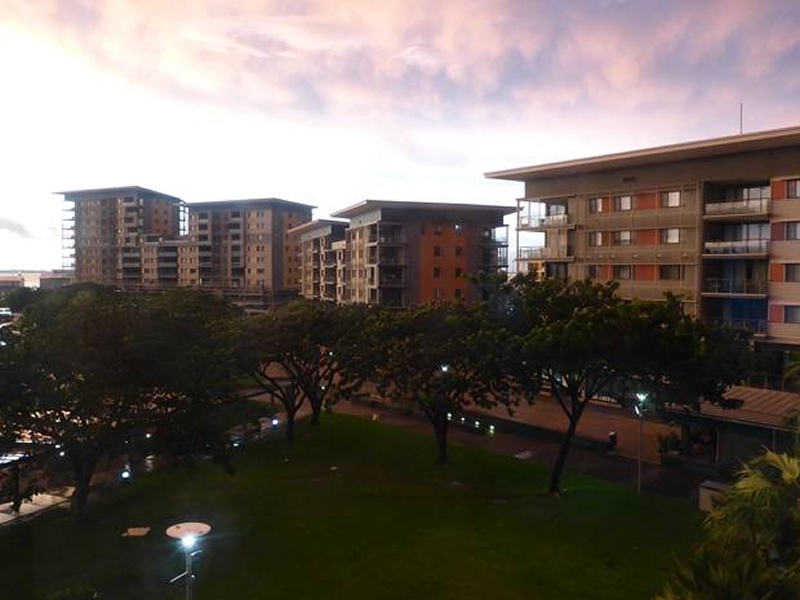
Dennis’ Wonderful Wetlands in Kakadu National Park
We were fortunate once again to have yet another intelligent and engaging driver/guide for our day of adventure to and around Kakadu, a World Heritage Site and Australia’s biggest National Park. Michael is an animal lover and was mortified every time we came across roadkill, “I just hate to see that,” as we passed a decomposing wallaby, “but it’s an inevitable part of our pace of living isn’t it guys, if we drive we sometimes kill.”
It’s a long drive by English standards but a short one for Aussie’s, broken and shortened by Michael’s continuous interesting commentary. He mentioned the local marriage arrangements, around 16 skin types which are mixed completely over four generations of marriages keeping the blood lines healthy and referred to as Patrimoieties.
Numerous crows were dining out on the roadkill and Michael mentioned how the crows in the area have taught the local kites how to eat dead cane toads from the tummy up and not through the back which is poisonous. “How does a crow on one side of the road warn his friend in the middle that there is a car coming around the bend?” Silent pause, “He yells, car car!” He deserved more laughter but I think it was still too early.
There were lots of pretty mid brown and very shy ‘agile’ wallabies around too, “I used to have one as a pet and he was a good pet and loved buttered toast. Sometimes he would disappear for a few days then return and hop onto my bed as if to say, “Come on then get up, I have something to show you!””
The area just outside Darwin is home to a big mango and dragon fruit farming industry that exports far and wide and as we drove along the near empty highway passing the new Palmerston which was developed in the 1980’s, the planned satellite city of Darwin, Michael explained how the area still hosts visits from the military from all over the globe. Numerous trails we saw diverging from the sides of the highway and disappearing into the bush were sometimes the tracks leading to the homes of cattle and Asian swamp water buffalo farms as far as 150km further along them.
A while back it was the Aborigines who stopped the slaughter of cattle and buffalo which the ranchers had started because of Brucellosis. We came across one of the remaining few pink skinned and placid buffalo (unlike their charcoal and aggressive counterparts in North America) when we stopped for a snack before entering the National Park. She was by herself in a small pen with a pool to languish in and welcomed some company and a stroke of her bristly nose. Today’s buffalo farms in north Australia vary in size from 30 or so to many thousands and both the animals and their products are exported to south east Asia and processed into foods such as the famous mozzarella for the home and global market.
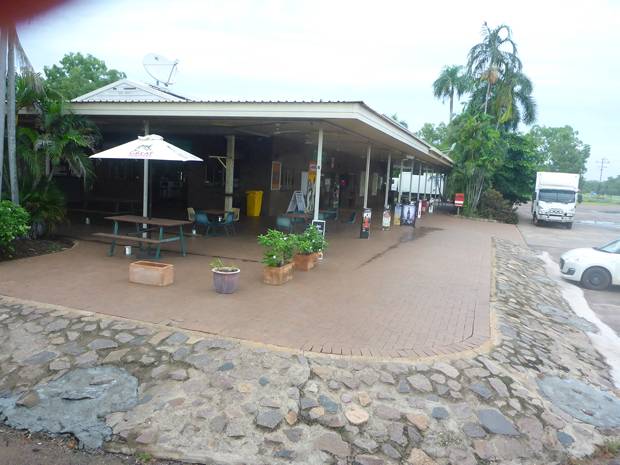
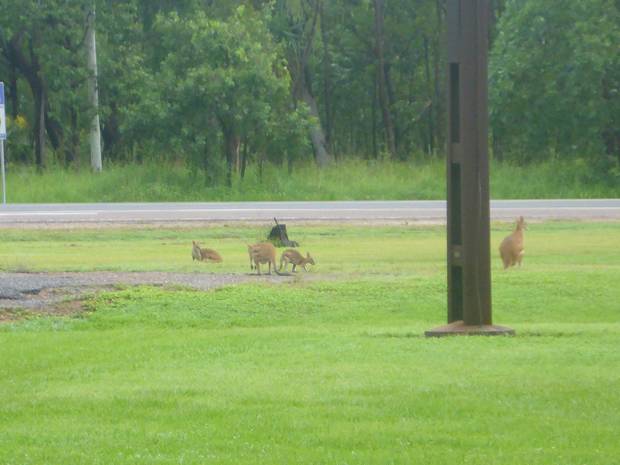
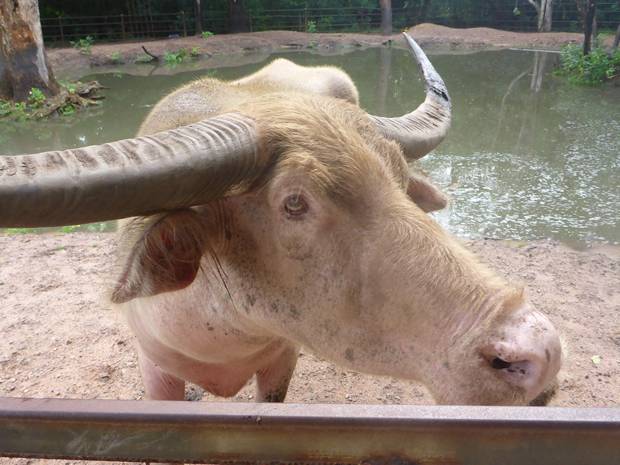
Soon we crossed the boundary into Kakadu and spent a few minutes absorbing the aboriginal way of life through the annual clock of the seasons you see in the photo and the flow of life through journeys and the passing down of sacred routes through their songs at the Warradjan Cultural centre. I cannot give you more detail here as photos were not allowed in the centre.
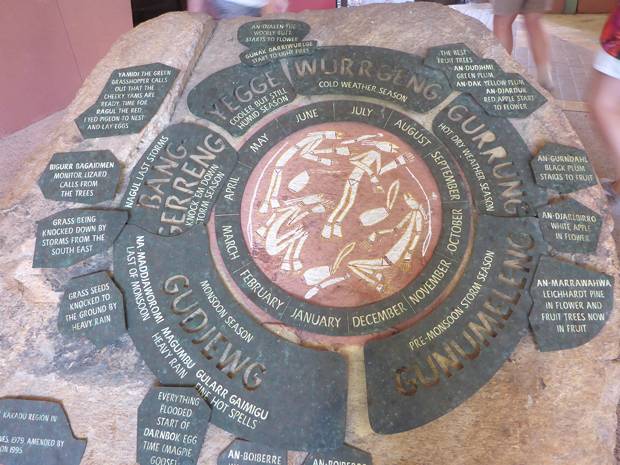
We came to a junction in the road near Jabiru and Michael explained how uranium mining over the years has complicated the return of land title to the local Mirrar clan, the traditional custodians, by the Commonwealth Government. The issue is a controversial one and the elders have never accepted the pastoralism and mining enterprises in the area.
“Terra nullius is the biggest lie on earth,” Michael explained with feeling. “At the same time title to our lands was returned in 1965 high grade uranium was discovered in the fledgling National Park. Just one shipping container would carry $100 million worth. So having been given back land titles by the Commonwealth government the Federal Government started rescinding title over the uranium areas. There was much protesting but production went on with 10 elders on the management committee.”
In 1981 almost all the mines except the Ranger Mine near Jabiru were closed and white farmers were moved off the growing National Park area. There is a plan to close the mine by 2021 when the lease runs out but as the town of Jabiru has grown up not only as a home for the mine workers but also a hub for tourism, National Park activities and more importantly a centre for the local clan residents which includes health care, schools and vital shops it is the survival of Jabiru itself that is in threat. High level talks with the Federal and Commonwealth Government and the mine lease holders ERA (Energy Resources of Australia, of which Rio Tinto is the majority shareholder) are on-going to put an end to the uncertainty.
The elders recently turned down a $5 billion offer for land which contained gold lying over uranium of the purest kind so you can see that Kakadu is a controversial area where different groups are waiting like predators for the chance to make a fortune.
Michael mused over the traditional reasons for fighting in the area, “Superstitions, sacred grounds and wives!” Once the people were healthy, respectful and family planning was part of the social structure. “We used to eat superfoods, the local tiny fig, the same size as a finger nail contains ten times more Vitamin C than an orange.” Just as we learned from Mulgun Wirrpanda with her fine paintings the locals were fit and healthy until white sugar and white flour arrived with the white men and survival of the traditional ways depends on resistance to the white man and isolation from him back on their own lands.
We paused and looked at the now flooded road leading to Jabiru and I wondered what it would be like to visit the area in the dry season and see how the locals are getting on.
Finally we arrived for our trip on the Yellow River Billabong with Dennis, another fulsome character “That’s Dennis with two nns because that’s how you spell Dennis.”
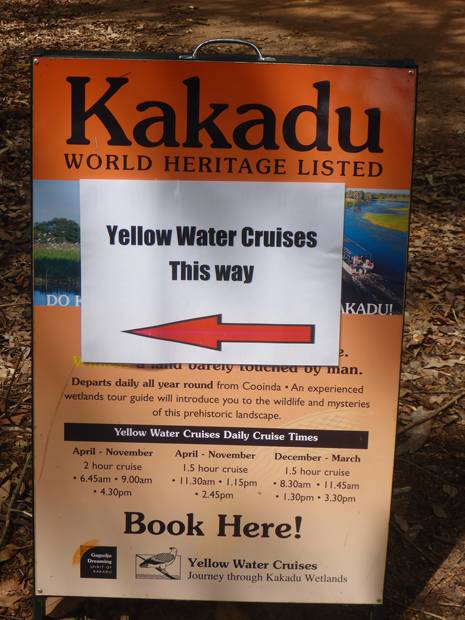
The water level has another metre or so to rise and already the walkways through the wetlands are underwater. While the air temperature is so high the 1600 or so saltwater crocs in the area take a deep breath, reduce their heart beat to 3 per hour and sink to the billabong bottom and rest for up to 3 hours at a time around the hottest part of the day, so that kind of ruled out the possibility that we might see one. But there was plenty for us to see besides the bumpy snout and steely gaze of a crocodile.
As we slid along the water towards the billabong and South Alligator River beyond we had to pass through a small channel. “Prepare yourselves ladies and gentlemen, we’re going in (to this small channel) and people on the outside may experience branches.”
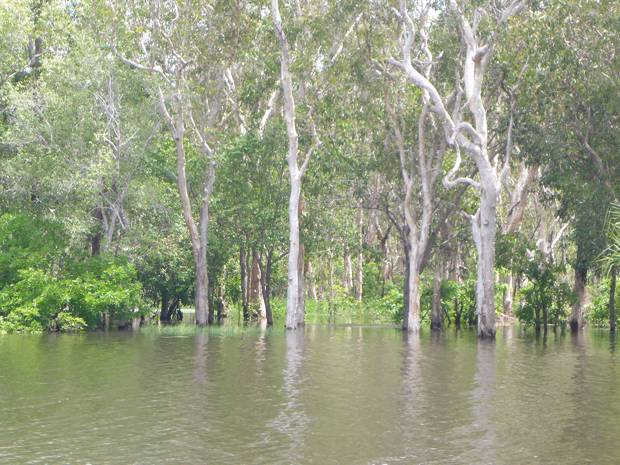
A comedic “Ooooh” came from some of us gathered.
“Goomagen is our name for the fresh water crocodile which grows to 3 metres long, say Goomagen.” (my spelling) We all obliged. “Ginga is the much bigger salt water crocodile, say Ginga.” Again we obliged.
“The little Goomagen can escape from the Ginga by slipping between the Melaleuca paper bark trees. In the dry season Ginga sit on the walkways waiting for one of our creators, The Rainbow Serpent to come through. The Rainbow Serpent flies along the rivers, gorges, streams and creeks. He doesn’t like loud noises or crying, that’s what we were always told as kids, or it would take you away the old people would say.” A general tone of agreement and consent followed.
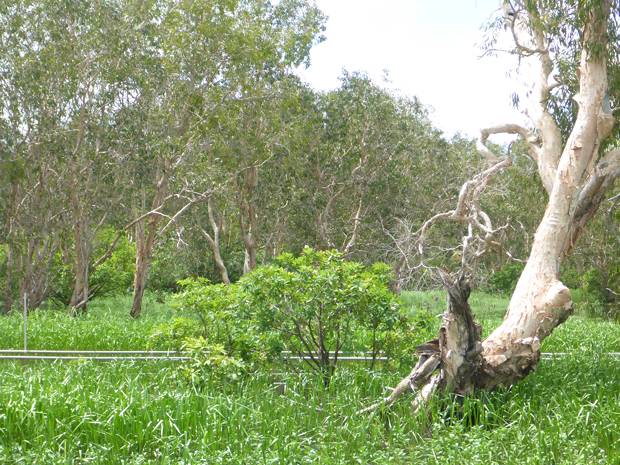
“We’re going in between two paper bark Melaleucas at the end of this channel now.” In their uneven and peeling bark they towered above us raising our gaze as we emerged to see a goshawk circling and a group of black and white Magpie Geese gliding over the billabong ready to land.
The area opened out to a vast area of lush shiny green floating reed and lilies, dotted with trees that withstand being partly submerged for half the year. In the branches of one a black cormorant stood, his wings outstretched, “He’s showing you the size of his last catch,” Dennis explained to the delight of the group. In the far distance were umbrella canopied kapok trees that stood above and behind the rest, the first we had seen since our journey on the Ecuadorian Amazon.
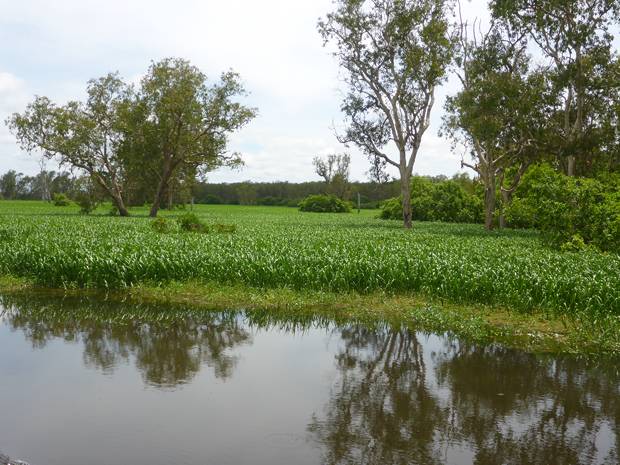
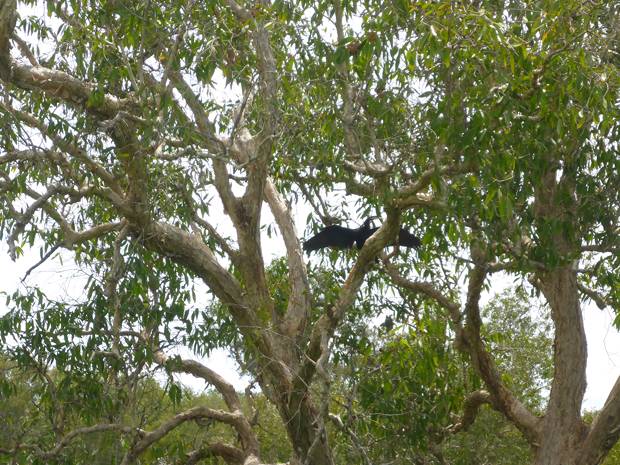
The lily leaves are totally waterproof and “Women use them to line their ditty bags when they are carrying water from the creeks. Lily roots are really good bush tucker.”
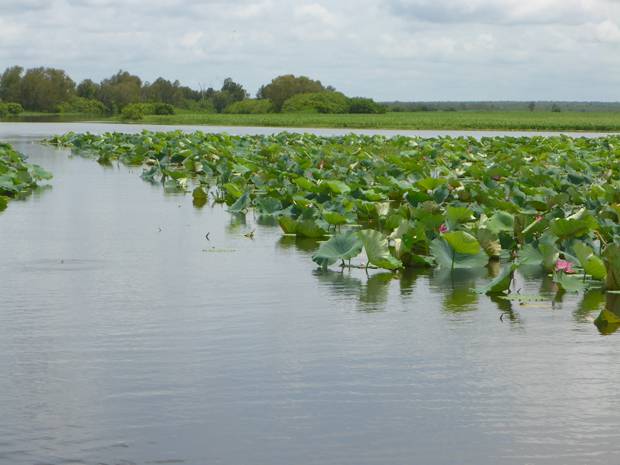
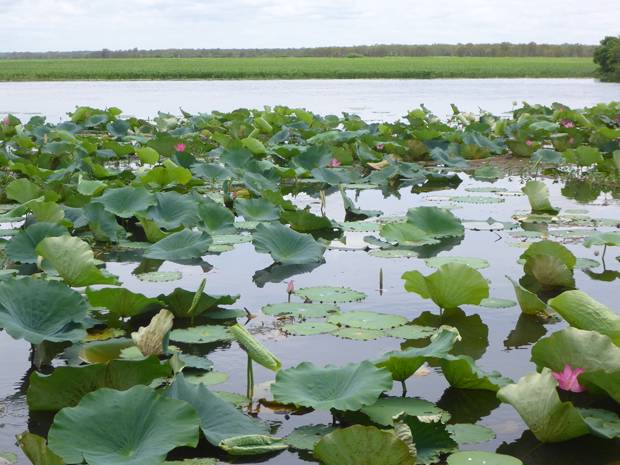
“Don’t they feed you in town?” One lady interjected as we watched pretty pink crested Jacanas step cautiously over the leaves, hence their other names of Lily Hoppers and Jesus Birds. (The males do all the incubation and rearing of the chicks and he tucks them under his wings when danger threatens and carries them away to safety.)
“40% of my diet still comes from the country, 40% from Woolworths and,” pause to allow for laughter, “20% from the Chinese in town.”
We nudged the boat into a reedy area and let it sit on the bank for a few moments to take in the ambience then Dennis broke the temporary silence with, “Always think we might need to get some of the fellas up front to hop out and push at this point, not the ladies they’re too important in your tribes eh?” Some one-sided and higher pitched approval.
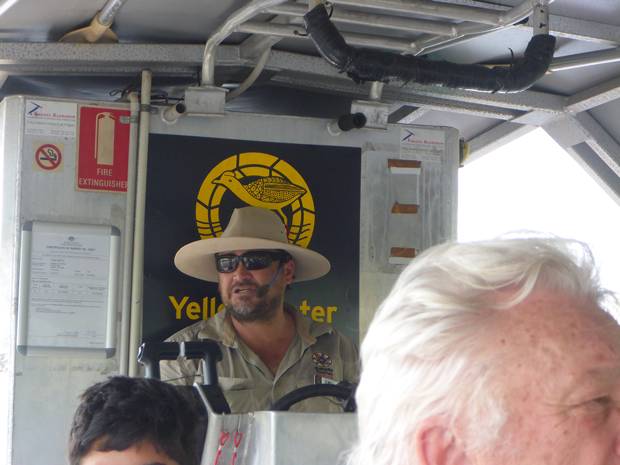
“We used to get a lot of guanas but the cane toads sorted them out 15 years ago and these are fresh water mangroves, not mangoes, mangroves!”
We passed a female snake necked Jabiru sunning herself on a branch and looking a little like a shag.
He went on to explain that Kakadu is the cleanest National Park in the world. Feral animals including buffalo, cane toads and pigs are shot to preserve the original habitat. One third of the Australian bird species plus 10,000 species of insects and 300 species of fish live in the park. From the well-rounded figures I suspected a little more accuracy was needed. However I liked his description of the park as a diverse organ with a wild climate and the rigorous survival of so many species where genome gigantism exists amongst species of flora and fauna due to lack of predators and once sabre toothed tigers roamed. And alongside all of this humans thrived. The park bans guns, pets and traps and with the abundance of water and dedicated care of the clans the existence of Kakadu appears to be well set.
For us it was time for a delicious buffet lunch at the lovely Cooinda Lodge just a short distance away on Michael’s coach before moving on to learn more about rock art.
The Gunbim in the Anbangbang Gallery – A Story of Aboriginal Rock Art
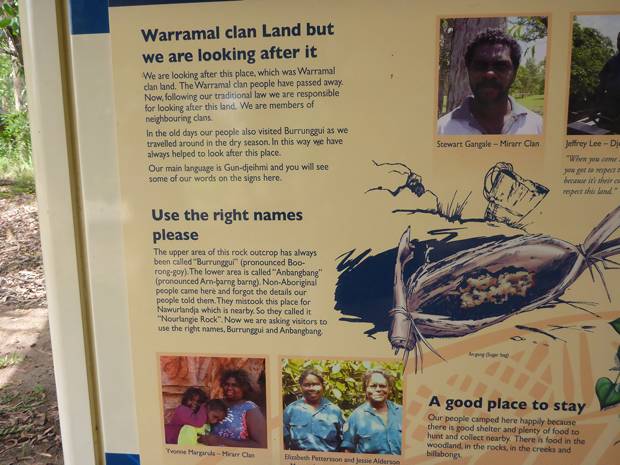
This was a personal journey for Michael as he hosted us through the private lives of his ancestors. I felt the burden of respect for what he was saying and for the need to behave in a way that was considerate towards his memories and the sacredness of the surroundings. People actually lived, made many sounds with chatting and sometimes loud dancing, went through their daily round, just as we do, of chores, gathering food, see the still sharp lines of the kangaroo and hunter holding the tether on the spear so he can propel it even more quickly and accurately just as dog walkers can whip the ball away using that floppy spoon toy today.
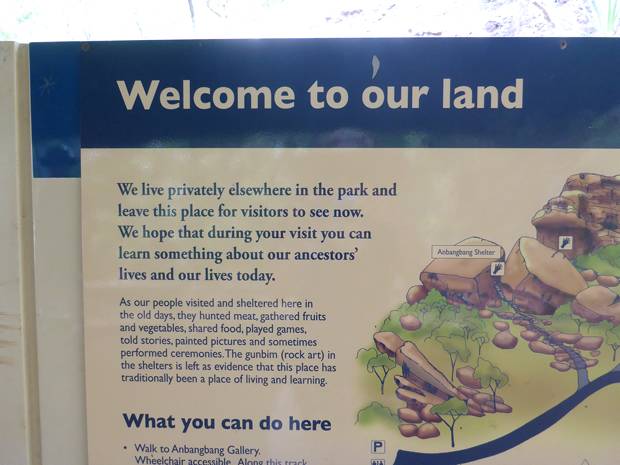
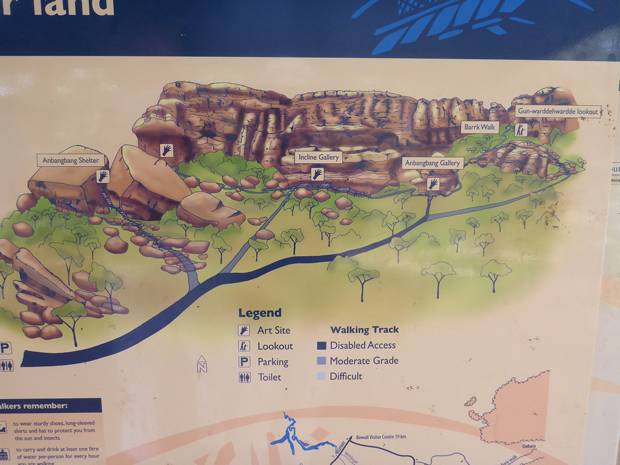
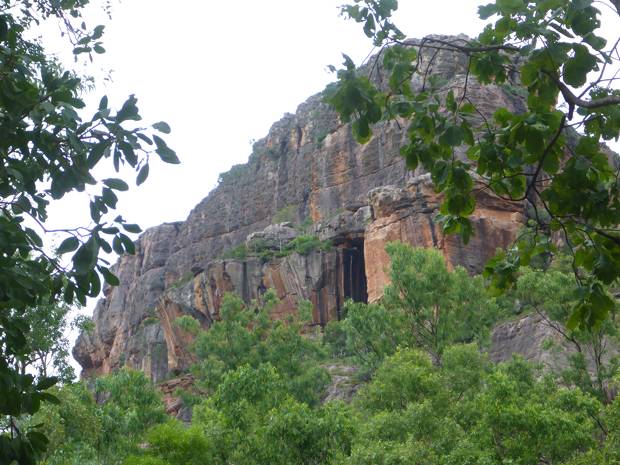
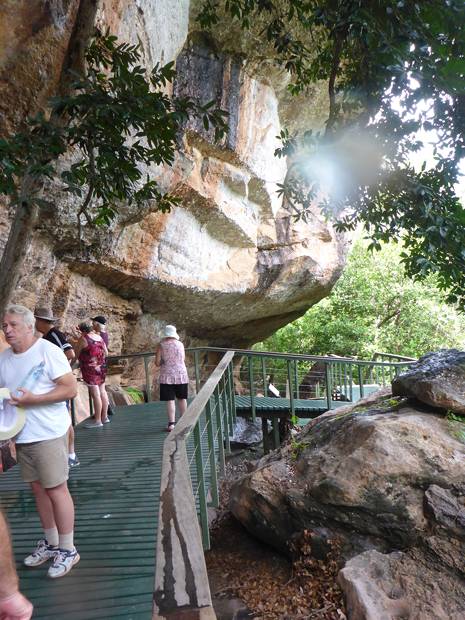
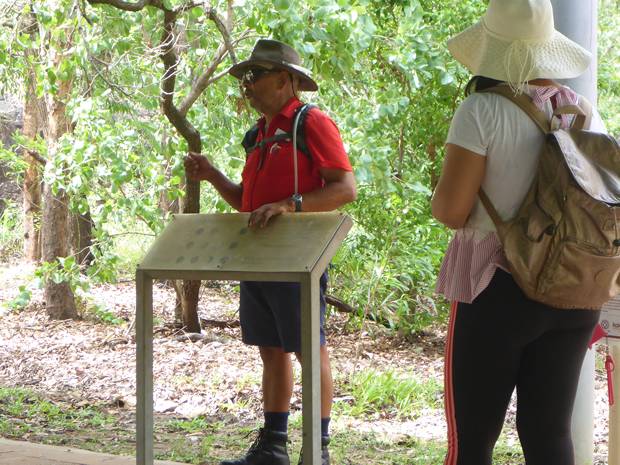
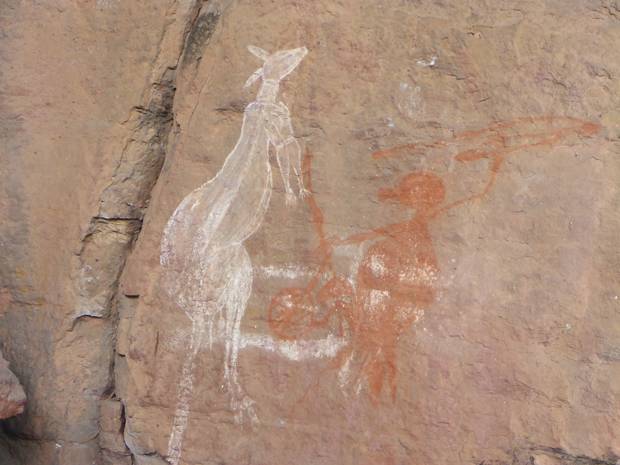
Jamey back in Nitmuluk Gorge had said that because women were busy caring for children and the elderly and gathering food and water they didn’t have time to do rock paintings. I question that because men also had their work to do, so it seems more likely that men and women contributed to telling their story for future generations. Besides, if women were doing the domestic chores and looking after children they were nearer the rock walls for more time than the men and would have been the ones to teach children the stories of the spirits and flora and fauna from which they came.
I felt a real connection with these ancestors as we looked at the little circular hollows in the rocks where they used to grind the rock and mix their paints, imagining their bronzed hands working away, the same hands that held the little pooters or straws through which they blew the paint over the hands of another straight onto the rock.
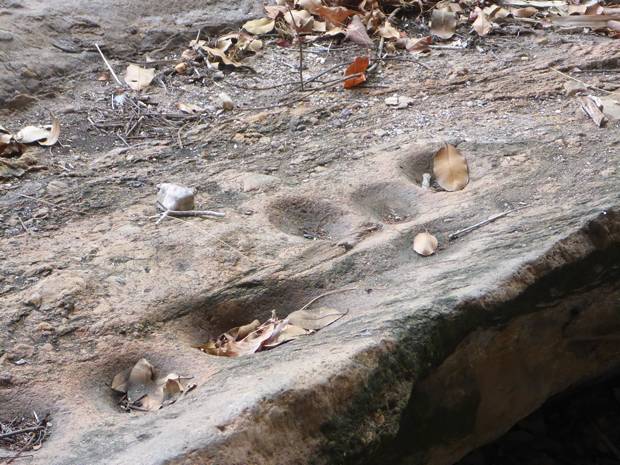
The Bogeyman or Nabulwinjbulwinj was a terrifying character with his fat legs and fan shaped headdress. Children were warned about him just as they are today. All societies seem to have them. While we were in Australia and just previously in New Zealand an Israeli girl in Melbourne, Australia and an English lass, Grace Milane recently arrived on her travels to New Zealand were both murdered by men acting alone with evil intent and all through my adult life I can remember many such assaults on beautiful young women. It is bad luck to photograph the actual rock painting so here is a copy.
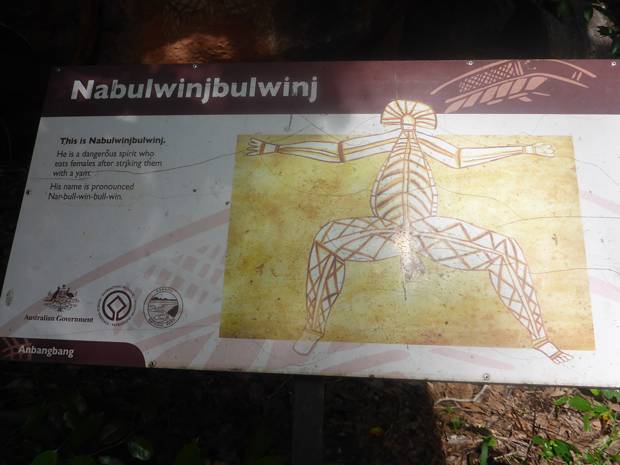
Another purpose of rock art was to record occasions of dancing just as a newspaper or TV report might today. These dances were not only celebratory. The song lines of the aborigines also gave directions for routes as they travelled across country and were sung to children as a way of preparing them to travel around the area where they lived.
Today aborigine professionals including professors who have chosen a life in the white man (balanda) society of Darwin ‘go to country’ as Michael explained, to learn the ways and laws of their people if they want to become elders of the clans.
One interesting aspect of their more recent work was the export of buffalo and kangaroo hides. The men would have hunted them between the 1890’s and 1960’s on the Nourlangi, a cluster of creeks where escapees from farmed herds wandered free. The women would prepare the hides and then punt them down the South Alligator River to the sea. They learned about tide times and would punt on out to the waiting ships with their lucrative cargoes.
One of the paintings, the one with lots of stick figures shows a pregnant woman up on the right hand side with her rounded belly. Other women are discernible as they are painted with breasts. When a woman was ready to give birth she would go to a women only area and be supported by a group of other women from her clan. I think it likely these aspects of their lives were depicted by the female side of their society. Isn’t the painting of the foot delightful? Apologies for the poor quality of the enlargement.
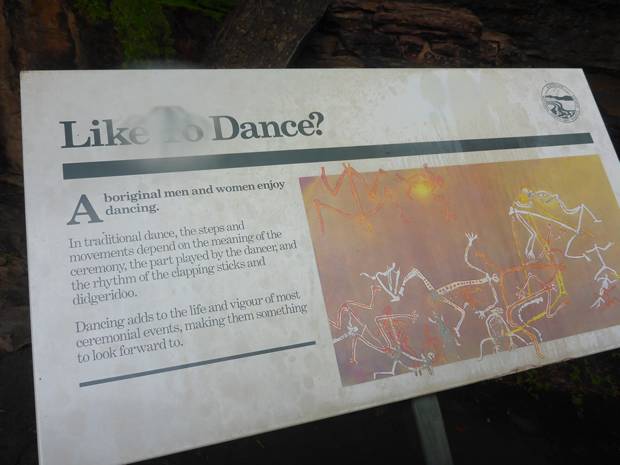

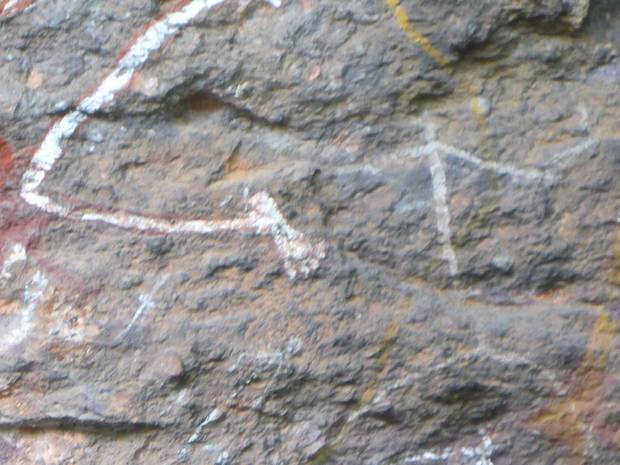
Another reason behind their artwork is to preserve the story of the spirits. Ones that stood out for me were the Lightning Spirit and his wife, Namarrgon and Barrginj and the tail and head depictions of the Guluibirr or Saratoga fish show a careful attention to the detail of this attractive fish.
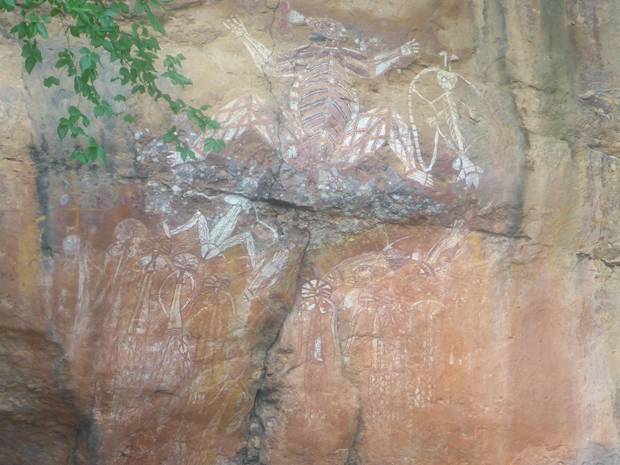
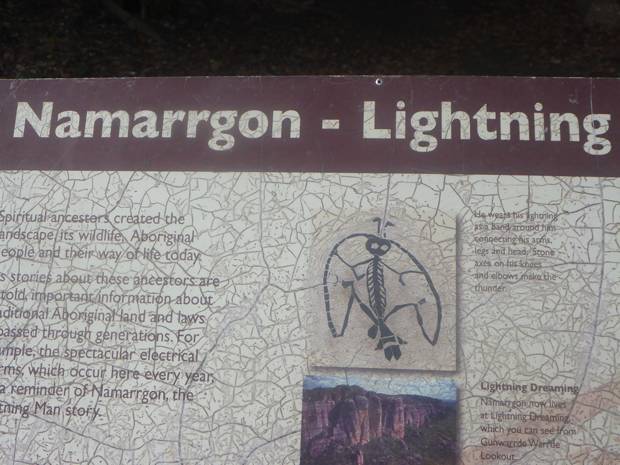
On our coach journey back to Darwin Michael told us about how some clans were run by women and those were always civilised and well organised and they “forged successful ways” which ensured their survival. This reminded me of the video Rob and I watched at the National Library in Canberra. The lady commentator was explaining that her ancestors in the 1760/70s were the women who ran the community at what is now called Cooktown, where Cook first landed on the east coast. It was their civilised and hospitable attitude towards this complete stranger and his ship’s crew that made this auspicious event a success.
It was Michael who made our visit so interesting and enjoyable with his talent for embracing a group of strangers with warmth and generosity. The aborigine attitude towards the first arrival of balanda is not universally as benign and accommodating as we were to learn the next day, Australia Day, or Invasion Day as it is also called.
Ban Australia Day? And where are these obscene souvenirs coming from?
The TV reporter back in London was delighted to show us the banner hanging over the side of London Bridge which read ‘Abolish Australia Day’ and was allowed to hang there for a few hours, blowing gently in the breeze until the authorities told the protesters to remove it. It had served its purpose, carrying the message to millions of screens all over the world.
Back in Canberra a polished crowd had gathered on the grass infront of the Tourist Centre at Regatta Point underneath a perfect blue sky, next to where we had sped by on our bikes just nine days before. Various dignitaries gave speeches which spoke of the glossy iceberg tip of political aims and ideas and two mixed Bininj and Balanda people gave their version of their Australian experience and hopes for the future and Rob and I were left wondering what ordinary Aussies of both backgrounds thought. My notebook reads ‘lots of shiny white folk with hollow words and insincere promises and ‘white aborigines’ – the acceptable face of aborigines?’ (More like the aborigines who have integrated and are trying to make changes from within white society)
Across the lake, still in Canberra at the Aborigine Parliament, a cluster of tents, caravans and containers infront of The Old Parliament House, hundreds of native and new Australians took part in a protest rally to push for the abolition of the annual celebrations of the day in 1788 when the first fleet of British ships arrived at Port Jackson, NSW.
Once that part of the day was done Rob and I were free go and find lunch, a pint of ’50 Lashes’ and a shared pizza and take a walkabout in town to stretch our legs and find a boomerang to add to the gift collection for family back home.
There are a few street dwellers around, living rough just like in most cities throughout the world. I was reminded of what the young girl had said in the lift in Adelaide, “Watch out for the abos”. Some liked to have a chat and I sensed they had not been homeless for long, their clothes and bedding were clean. Michael had told us that they come into Darwin in the wet season because their homes are flooded, but that would not have happened back in the days of clan living so at some stage no doubt for numerous reasons they had become displaced.
If Bininj people return to their clans with drink or drug problems they often face rejection or even worse so they become trapped between two societies unable to live well in either.
Our exploration of the souvenir shops was revealing. We explored the flight quality of various boomerangs and it appears they were traditionally made from the roots of Mulga or Black Wattle. A part of the root that was already in the shape of a boomerang was chosen because where the grain followed the shape, the tips of the boomerang would be less inclined to break on landing. The one we bought is made of plywood and came painted with authentic designs dating back to the past.
While wandering around the shelf units my eyes fell on a box full with kangaroo scrotums and next to it another full with their black clawed paws, that was after passing a pile of their skins by the door. As I have mentioned there used to be a good trade in animal skins ferried down the South Alligator River to ships waiting offshore. But I wondered about the thinking behind making kangaroo parts in to souvenirs and the thinking in the buyers’ minds too. Maybe they were the product of culling.
In parts of Australia kangaroo are culled at a rate of 1 million per year to prevent them from competing with farmers and damaging endangered grasslands and wildlife. There has been a quota on the numbers that can be culled but this is not regulated. In the last 20 years the population of kangaroos has been reduced by 90 million through culling.
Understandably this has divided opinion in Australia and one academic view is that a report promoting culling ‘lacks analytical and ethical credibility and as a document that seeks to destroy the lives of sentient beings and their dependent young should be discounted as wholly inadequate and lacking moral foundation’. And many Australians agree. For as long as they are now treated as pests the future of this quintessential Australian marsupial is by no means secure.
Also during our ‘shopping’ expedition we admired the beautiful artwork of local aborigine ladies who produce colourful high end woven fabrics and paintings for the tourist trade. These are retailed through high street outlets and on the internet and a portion of the profit goes back to the artists. As we were flying I didn’t buy anything, instead collected business cards so that one day, when we are sitting in our as yet fictitious home back in the UK we can choose some lovely designs to decorate walls, windows and settees. That’s the idea anyway.
My point is that if it is women who are producing this modern aboriginal art and craft then is that a new thing or are they continuing an ancient tradition but with a modern commercial slant? My gut feeling is that it is the latter.
We did buy a boomerang but I have a feeling that after bringing it all the way back to the UK it might just end up on the wall just outside the booze cabinet on Zoonie!
After all that ‘shopping’ we wandered back to base camp knowing this would be our last time on the friendly streets of Darwin. We dined on a Greek salad for me and a steak mignon for Rob sitting people-watching outside the Fiddlers Green before returning to the room to watch the evening celebrations of Australia Day in Sydney.
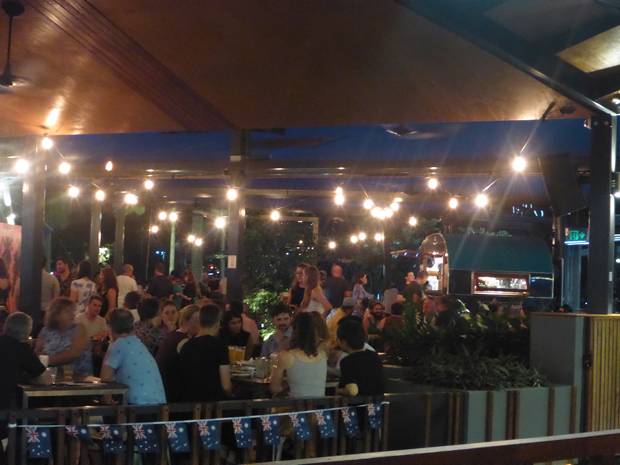
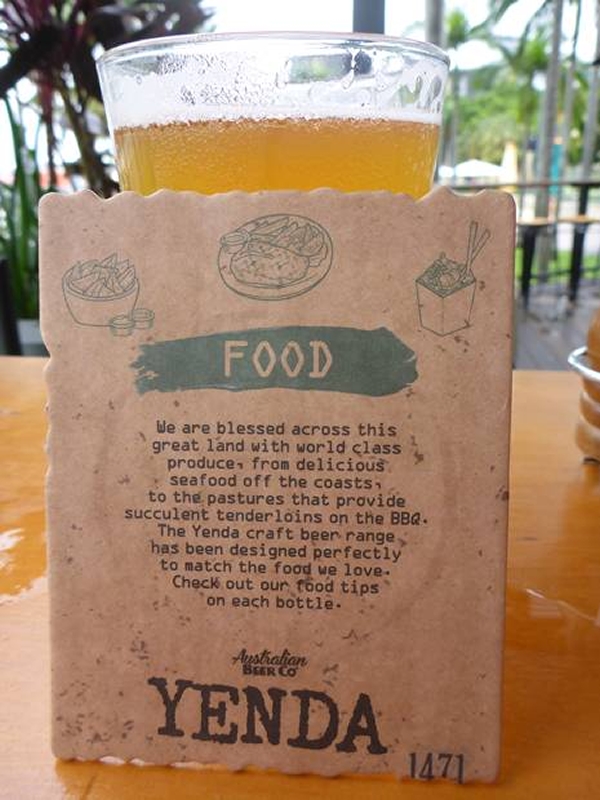
The combination of darkness and the lights of the show made for a colourful spectacle. Sailing yachts dressed overall with blue lights did a synchronised dance around Circular Quay and men on water jets that lifted them high into the air performed a water ballet but most impressive for me was the stage performance of Yothu Yindi’s ‘The Treaty Project’ band from Arnhem land. Co-founder of the band, Witiyana Marika said he does not support changing the day of the celebrations. He feels privileged to be part of the January 26 program and the group wanted to celebrate unity and redemption.
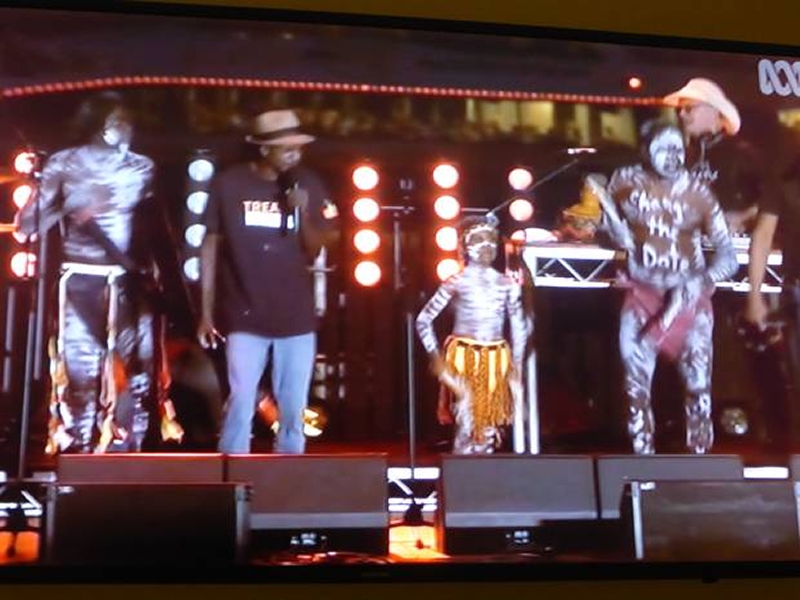
Their music had a lovely beat and lots of meaning in the song lines. The use of the didgeridoo added a richness akin to kettle drums and the crowd seemed appreciative too.
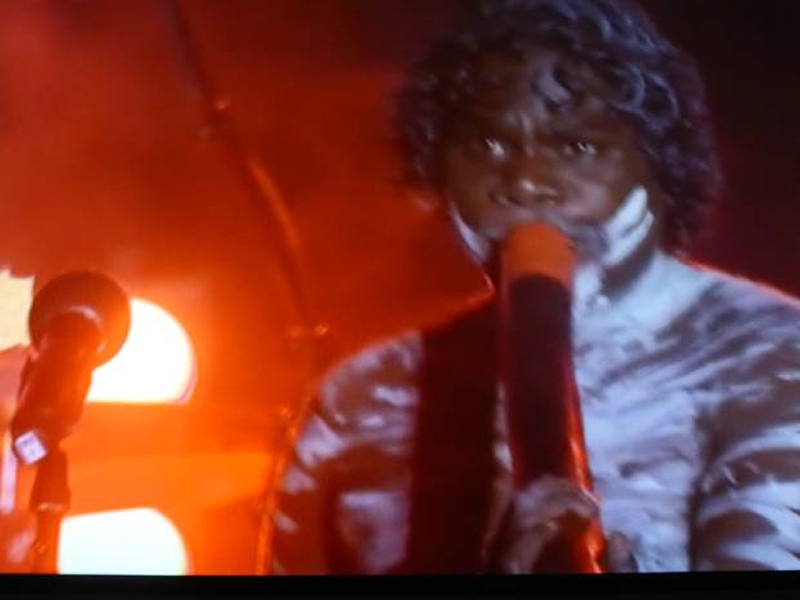

Looking at a couple of polls on the topic one showed that three out of four people believe the date should remain the same and only 10% of 1000 people wanted it changed. What proportion were first nation voters I am not sure.
The more aborigines can become part of the modern Australian way of life the less they will want to change the date and instead see it as a way forward to a united future. It is a complex issue for sure.
We were coming to the end of our second honeymoon in Darwin and right from the start had promised ourselves a swim around the lagoon that was once an inner harbour. It is the big area with the recreation inflatables. Well the water was like a pleasant bath as we gently swam the distance, hoping there wasn’t a hole in the crocodile net across the entrance, checking in the water for jelly fish and keeping out of the way of the dedicated regulars as they ploughed confidently around taking no prisoners. It took around 40 minutes and after we’d wandered back to our room through the sweet scent of frangipani blossom I rewarded myself with a relaxing bath, speaking of which that is where I am going right now in chilly, wet, windswept England.
